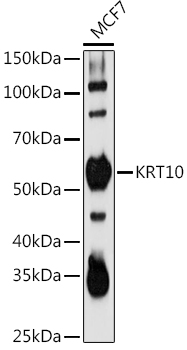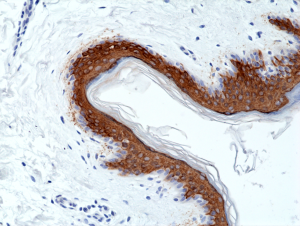Mouse anti Cytokeratin 10 / Keratin K10
MUB0320P-CE/IVD
ApplicationsFlow Cytometry, Western Blot, ImmunoCytoChemistry, ImmunoHistoChemistry, ImmunoHistoChemistry Frozen, ImmunoHistoChemistry Paraffin
Product group Antibodies
ReactivityCanine, Feline, Human
TargetKRT10
Overview
- SupplierNordic-MUbio
- Product NameMouse anti Cytokeratin 10 / Keratin K10
- Delivery Days Customer7
- Application Supplier NoteDE-K10 is useful for immunocytochemistry, immunohistochemistry on frozen and paraffin-embedded tissues, immunoblotting and flow cytometry. Optimal antibody dilution should be determined by titration; recommended range is 1:100 - 1:200 for flow cytometry, and for immunohistochemistry with avidin-biotinylated Horseradish peroxidase complex (ABC) as detection reagent, and 1:100 - 1:1000 for immunoblotting applications.
- ApplicationsFlow Cytometry, Western Blot, ImmunoCytoChemistry, ImmunoHistoChemistry, ImmunoHistoChemistry Frozen, ImmunoHistoChemistry Paraffin
- Applications SupplierFlow Cytometry;Immunocytochemistry;Immunohistochemistry (frozen);Immunohistochemistry (paraffin);Western Blotting
- CertificationResearch Use Only
- ClonalityMonoclonal
- Clone IDDE-K10
- Gene ID3858
- Target nameKRT10
- Target descriptionkeratin 10
- Target synonymsBCIE, BIE, CK10, EHK, EHK2, EHK2A, EHK2B, IHL, K10, KPP, keratin, type I cytoskeletal 10, CK-10, cytokeratin 10, keratin 10, type I
- HostMouse
- IsotypeIgG1
- Protein IDP13645
- Protein NameKeratin, type I cytoskeletal 10
- SourceDE-K10 is a mouse monoclonal IgG1, kappa antibody derived by fusion of SP2/0 mouse myeloma cells with spleen cells from a (BALB/c x B6)F1 mouse immunized with a cytoskeletal preparation extracted from human epidermis.
- ReactivityCanine, Feline, Human
- Reactivity SupplierCanine;Feline;Human
- UNSPSC12352203





